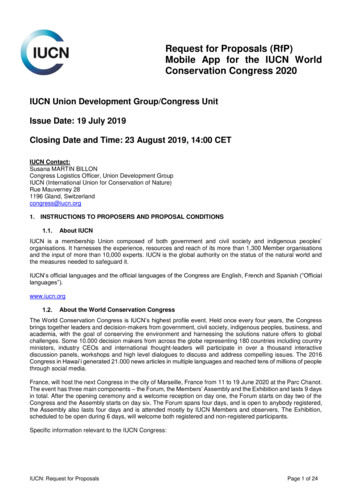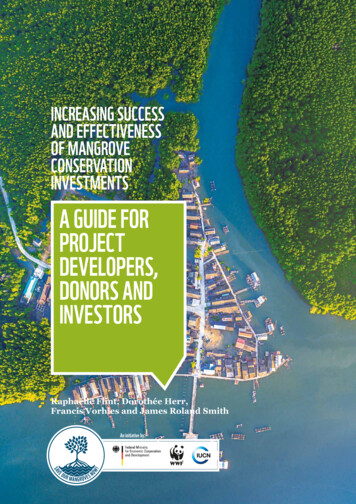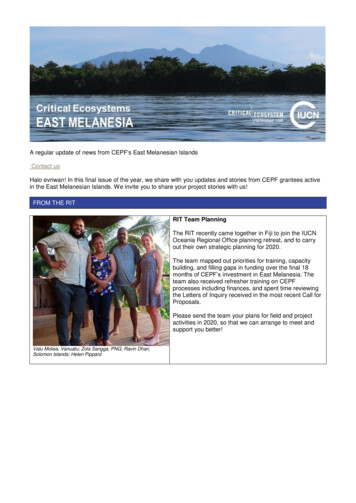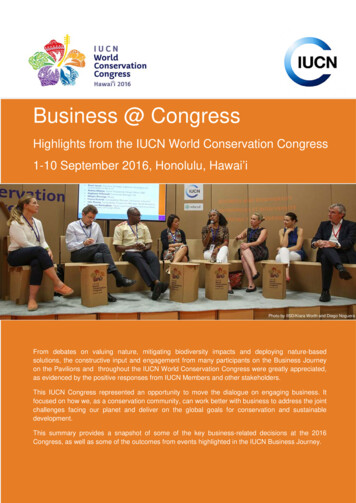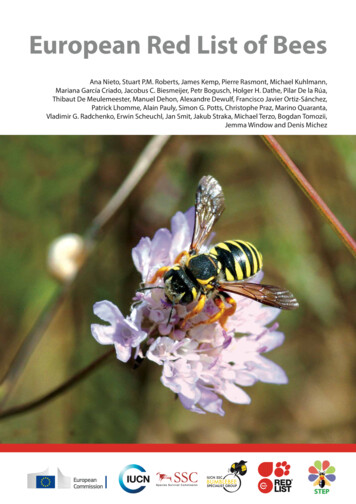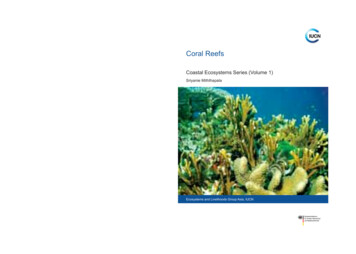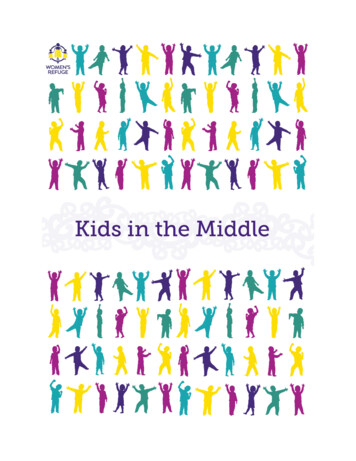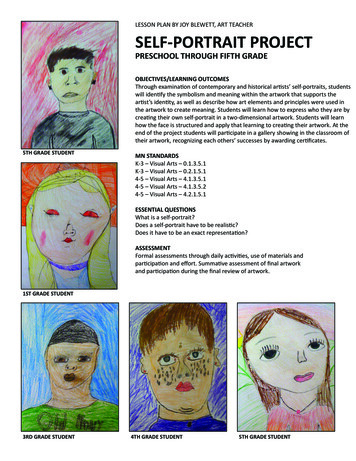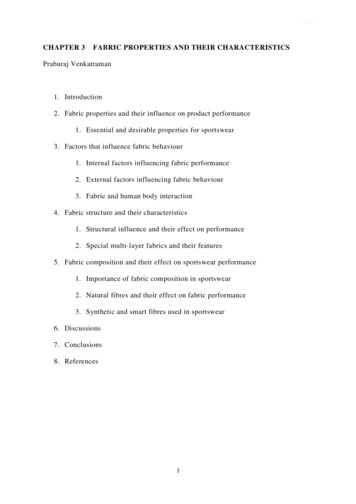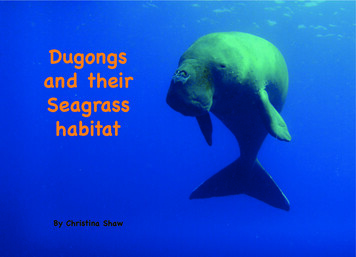
Transcription
Dugongsand theirSeagrasshabitatBy Christina Shaw
DugongsDugongs, also known as Sea Cows are largecharismatic marine mammals that live in tropicalcostal areas. They are found along the coast ofmany countries around the Indian and PacificOceans from the coast of India to Vanuatu.They are large animals and can grow up to 3 metersin length and weight up to 500kgDugongs are herbivores, which means they only eatplants. The diet is seagrass and they eat a lot of it.They can eat up to 40kg of seagrass every day.Mammals are warm-blooded animals with backbones.They are different form other classes of animalsbecause their babies are born alive and suckle milkfrom their mothers. They have lungs and breath air.Their skin has hair or fur.Dugongs are mammals and they need to come to thesurface of the sea to breathe. They have hair, althoughnot very much of it. The calves drink milk from theirmothers.
The Dugongs’ CousinsA dugong’s closest relative is the manatee. There are four species ofmanatee and they live in the Americas and Africa. They are all in theorder of Sirenia, which means mermaid. There was another closelyrelated species called the Stellar Sea Cow but it is now extinct. In theeighteenth century man took just 27 years to hunt them until everylast one was gone.Manatees have a paddle shapedtails. Their mouths point moreforwards so they can eat thevegetation from the banks ofrivers.Dugongs have a fluted tail like awhale’s. They have flat mouthsthat are turned down to make iteasier to eat seagrass from thebottom of the sea.Did you know that the land animaldugongs are most closely related tois the elephant?The Mermaid mythPeople think that the myth ofthe mermaid might have comefrom sailors seeing dugongs andmanatees at sea. Mermaids aremythical creatures, half humanand with the tail of a fish. Theyare supposed to be beautifulwith long flowing hair. Do youthink dugongs are as beautifulas mermaids?
The Life Cycle of a DugongA young female dugong canget pregnant for the firsttime when she is between 4and 17 years old. She will staypregnant for 13 to 15 months.When a dugong is born itstays with its motherand drinks her milk forabout 18 monthsDugongs will have calvesabout every 2 to 5 years. Itdepends on how much foodthe dugongs are eating. Ifthere is not as muchseagrass the time betweencalves will be longer.Dugongs can live until they areseventy years old.The life cycle of a dugong is verylong. It takes a long time for themto grow up and reproduce. They arepregnant for a long time and theysuckle their calves for a long time.This means that if adult dugongs arelost from the population it take along time for the population torecover. This is why it is important, inparticular, to ensure adult femaledugongs are not accidently killed.
There are benefits of having dugongs in our watersDugongs are indicators of healthy seagrass beds. Dugongs cannot survive so if there is a healthy populationof dugongs which are breeding regularly it indicates there must be seagrass for them to eat.Tourists like to see them in the wild so dugongsare an asset for the tourism industry in thecountry. Seeing a dugong on a dive can be thehighlight of somebody’s holiday. Photo byChristina ShawWe like to see them - it can make us feel wonderat the natural world to have an encounter with alarge charismatic animal, like these surfers fromPango village. Photo by Feanzer Kalpep
Threats to DugongsDugongs are listed on the International Union for Conservation of Nature (IUCN) Red List of ThreatenedSpecies as ‘Vulnerable’. This means that they are at risk of becoming extinct. The number of dugongshas gone down in most places where they live.Dugongsdependonseagrass for food. Seagrassbeds are declining allaround the world. Ifdugongs don’t have enoughto eat they will not survive.Dugongs can get killed orinjured when struck by a boat.They are either struck by thehull of the boat or more oftencut by the propeller. This isknown as boat strike.Dugongs can get caught infishing nets and drown.Currentlythebiggestthreat to the survival ofdugongsworldwideisgetting caught in gillnetsThis is known as by-catch.In some countries dugongs are traditionally hunted. If too many dugongs are taken this is a threat totheir survival. Dugongs can also get entangled in marine litter and ghost nets. If dugongs are disturbedby human activity in and around their feeding sites this can also affect their survival.
What we can do to help dugongs survive. Look after seagrass beds. Take care when driving boats in areas where dugongs are known to go. This will reduce the change ofa collision and reduce disturbing them when they are feeding. If people, such as tourist, want to seethem, they should be approached slowly and quietly and not chased. Stop or reduce hunting of dugongs. Killing of dugongs is against the law in many countries. Ensuringthat the law is adhered to will help dugongs survive. Don’t leave fishing nets unattended especially overnight. If a dugong is found in a net, release it immediately. Be careful not to loose fishing gear in to the sea and adding to the ghost net problem. Don’t throw waste, particularly plastics, into the sea or on the land where it can be washed into thesea.
SeagrassesSeagrasses are flowering plants that have adapted tolive in the sea near the coast.You can find seagrasses in the inter-tidal zone (thearea of coastline which becomes exposed when thetide goes out) or in the sub-tidal zone (the areabelow the tideline which is always submerged)Seagrasses have a true root system and theyproduce flowers, fruits and seeds. Their leaves aresensitive to light and they produce energy byphotosynthesis just like the plants on land.Seagrass is sensitive to changes in: Depth - the deeper the water then less sunlightgets to the leaves. Salinity - how salty the water is. Turbidity - how cloudy the water is. This affectshow much light can pass through the water.
Seagrass is different from seaweedSeaweedA type of algaeDo not have veinsDo not have a root systemEither float or attach to rocks with a holdfast.They do not produce flowers, fruits or seedsDiagram from "Tropical Connections: eagrassA type of flowering plantHave veins in their leavesHave a true root system and can take up nutrientsfrom the groundRoots system grows into the sand or mudProduce flowers, fruits and seedsFlorida'smarineenvironment"(pg.250)-
Seagrass beds provide habitat for many different species of animals.Many different species of fish can befound in seagrass beds including,rabbitfish, goatfish, parrotfish andemperors.Seagrass beds are nurseries forspecies of juvenile fish that live on thereef as adults.Shellfish make their home in seagrassbeds.Seagrass is habitat for sea cucumbers,seahorses and sea starsDugongs and green sea turtles dependon seagrass beds for food.
Seagrass beds help keep the environment (and us) healthyO2O2CO2CO2CO2CO2O2O2Human activity is causing increases ingreenhouse gasses, including carbon dioxide(CO2), in the atmosphere. This is leading tochanges in the climate. The weather isbecoming more unpredictable with morestorms. As carbon dioxide dissolves in to water,the oceans are becoming more acidic.Seagrasses capture carbon. They absorb CO2and release Oxygen (O2). This helps to counterthe effects of climate change and reducesocean acidification. An area of healthy seagrass as big as a football field can hold asmuch as 10-15 times more carbon than thesame area of Amazonian rainforest.It is estimated that 10% of the annual carbonsink capasity of the oceans is due to seagrass.
Seagrasses work together with mangroves and the coral reefCoral reefs, mangroves and seagrass beds all stabilise the coastline and protect itagainst erosion, storm surges, Tsunamis and cyclones.All 3 of these ecosystems need the others to stay healthy and survive. Mangroves filter out the sediment and excess nutrient in run-off from the landand stops them damaging and smothering the seagrass and coral. Seagrasses stabilise the sediment and reduce the current andsurge somangroves can become established. Coral reefs reduce the energy of the waves and protect the mangroves andseagrass beds.Mangroves, seagrasses, coral reef and all the creatures that inhabit them, cyclenutrients that would otherwise be lost into the deep ocean. Many species usedifferent habitats for different stages of their life cycle and need all 3 to survive.Humans need all 3 ecosystems to stay healthy to protect our coastlines, give us foodfor our table and to reduce the impact of climate change. Seagrass beds arethought to be one of the most valuable habitats in the world in terms of how muchbenefit they give to humans.
Seagrasses are under threatIt is estimated that half the world’s seagrass beds have already disappeared. Seagrasses need sunlight to survive. Increases in turbidity will reduce the light getting to theseagrass. Mining, trawling, and increased run-off from the land increase turbidity and are bad forseagrasses. Dredging, land reclamation, inland and costal clearing can remove seagrass beds. Seagrass beds can be damaged by boat propellers and anchors. Sewage, litter and other waste products can harm seagrass beds. Aquaculture can cause increase in nutrient levels and turbidity Extreme weather events e.g. cyclones and flooding can physically damage the seagrass beds and canchange the salinity and turbidity, which can be detrimental to the seagrass.
We can help keep Seagrass beds healthy by: Reducing run-off from land into the sea e.g. by not removing vegetation close to rivers. Not trawling, mining or dredging near seagrass beds Looking after the mangroves and coral reefs Taking care when driving boats over seagrass beds Not anchoring in seagrass beds Keeping beaches and the sea free from litter Making sure sewage and other waste products do not get into the sea Monitoring seagrass beds to ensure they are staying healthy and resilient
This book was written and printed by The VanuatuEnvironmental Science Society (VESS) with funding from theCritical Ecosystem partnership Fund (CEPF)Images downloaded from Ian Image Library (www.ian.umces.edu/imagelibrary/) and created by:Charlene Afu, Catherine Collier, Jane Hawkey, Diana Klein, Kim Kraeer, Tracey Saxby, Jane Thomas,Dieter Tracey, Lucy Van Essen-Fishman and Joanna Woerner.Front Cover Photograph by Christina Shaw.
Dugongs are herbivores, which means they only eat plants. The diet is seagrass and they eat a lot of it. They can eat up to 40kg of seagrass every day. Mammals are warm-blooded animals with backbones. They are different form other classes of animals because their
